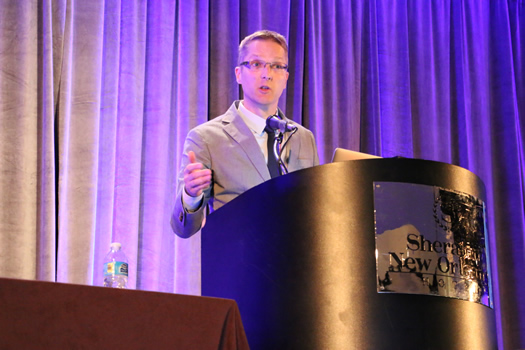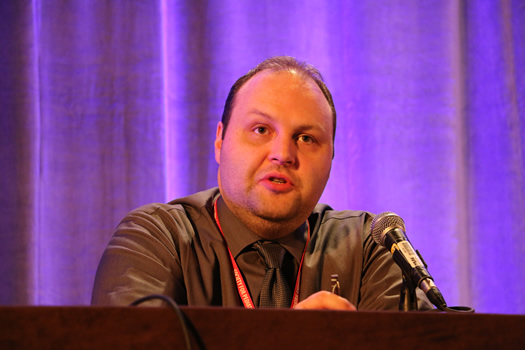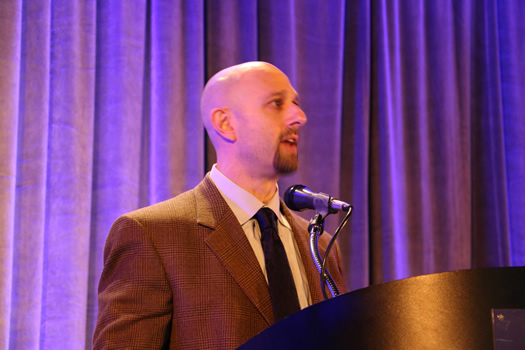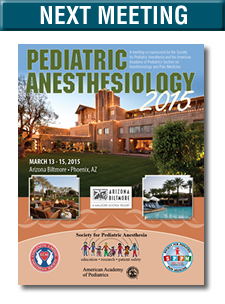SPA Annual Meeting Reviews
Session II: “Toxic Agents”
By Constance Monito, MD
Johns Hopkins University
Andreas W. Loepke, MD, PhD, from Cincinnati Children’s Hospital, started the session with a lecture titled “Anesthetic Neurotoxicity: Vulnerability of the Immature Brain or of Immature Neurons?” The aim of Dr. Loepke’s talk was to address three specific questions. Are all anesthetics similarly toxic? What is the effect of age during exposure? Which neurological domains may be affected?

Dr. Andreas Loepke
Focusing on the first question, he pointed out that at present, there are over 300 articles and abstracts that suggest that multiple anesthetic agents, including ketamine, propofol, inhalation anesthetics, and potentially xenon, can be toxic in multiple primate and non-primate species. Istaphanous (Anesthesiology, 2011) used cell death and caspase assays to compare sevoflurane, isoflurane, and desflurane, and found no difference between the three gases, but this “equivalency” is variable in other studies. Sanders (Anesthesiology 2010) found that co-administration of dexmedetomidine attenuated the observed neurotoxicity.
Considering the impact of age, Dr. Loepke reported that Yon (Neurosci 2005) demonstrated a window of neuronal vulnerability in the seven day-old rat. Utilizing data on brain growth from the 1960’s and 1970’s to try to compare rat and human brains, investigators have suggested that this vulnerable period could correlate with a wide range of human ages – from midgestation to four years. However, more recent evidence suggests different regions of the brain mature at different times and, hence, specific brain regions may be vulnerable even beyond three to four years of age.
Finally, addressing the question of which domains are predominantly affected by anesthetic agents he outlined our current understanding of sensitive periods for the development of specific neurological skills, and suggested that the currently observed heterogeneity of results in retrospective clinical studies could be impacted by the inclusion of patients having diverse ages in these studies as different brain regions may be vulnerable at different times.
The second speaker, Jason Maynes, MD, PhD, from the Hospital for Sick Children in Toronto, gave a thought-provoking lecture titled “How Off-Target is Your Anesthetic? Effects on the Mitochondria, Autism, and Cancer Metastasis.”

Dr. Jason Maynes
Dr. Maynes began his lecture by suggesting that anesthesiologists need to take a holistic look at how our interventions impact our patients’ physiology and metabolism. Focusing on the mitochondria as a mediator of cellular physiology, he reviewed its critical role in many cellular pathways including the cellular stress response, aging and neurodegenerative diseases, and the generation of reactive oxygen species as a non-pathologic signaling pathway.
He next noted that there are many different points in the electron transport chain where multiple anesthetic agents influence mitochondrial activity, while these drugs can impact mitochondrial integrity as well. For example, studies have shown that exposure to one MAC hour of isoflurane alters mitochondrial morphology, exposure to ketamine decreases mitochondrial biomass, isoflurane, propofol, ketamine, and midazolam can alter mitochondrial membrane polarization, and sevoflurane can affect mitochondrial fusion and induce protein misfolding.
In addition, various anesthetics can induce changes in mitochondrial DNA, and these changes in the mitochondrial genome can impact cell function as well. While opioids, in general, have less effect on mitochondrial function, Dr. Maynes pointed out that morphine is a specific inhibitor of isocitrate dehydrogenase (IDH-1), an enzyme involved in the conversion of isocitrate to alpha-ketoglutarate in the citric acid cycle. Importantly, mutations in IDH-1 affect DNA methylation, providing a potential link between the morphine we routinely administer and changes in DNA methylation, a finding not uncommon in various cancers.
Moving on, he reported that autism is the most prevalent secondary diagnosis in children undergoing an anesthetic at Sick Kids, while evidence of “atypical” mitochondrial deficiency is present in approximately 40% of children with autism, suggesting that this population of children may be particularly sensitive to our anesthetic agents.
Richard J. Levy, MD of Children’s National Medical Center closed the session with his talk “Carbon Monoxide: Toxicity and Potential Therapeutic Agent.” Dr. Levy informed the audience that carbon monoxide (CO), which is generally produced exogenously by incomplete combustion of carbon-related fuels, is the leading cause of poison-related mortality in the US.

Dr. Richard Levy
Once in the bloodstream, CO binds over 200 times more avidly to hemoglobin than oxygen, causing a leftward shift of the oxyhemoglobin dissociation curve, and impairing tissue oxygen unloading. Keeping with the session’s focus on the mitochondria, he reported that CO also diffuses into mitochondria where it binds complex IV in the electron transport chain, impairing ATP synthesis. CO production within anesthesia breathing circuits was first reported in 1990 by Moon et. al. It is generated by the interaction of anesthetic gases with the desiccant in the CO2 absorber. The lower the fresh gas flow, minute ventilation ratio and the drier the absorbent the more CO is produced, though production is significantly less with the newer desiccants.
In addition to the CO generated within the anesthetic circuit, we are also exposed to hepatically-generated endogenous levels of CO, which is normally excreted when we exhale. While we often focus on CO’s toxic qualities, low dose CO has cellular protective properties as well. Through its interactions with various mediators including the MAPK, Akt, and NO pathways, it has anti-inflammatory, vasoactive, anti-apoptotic properties as well. For example, cytochrome C release from damaged mitochondria causes apoptosis, while CO binding to cytochrome C can inhibit this pathway.
In light of this protective effect, Dr. Levy and colleagues embarked on studies to evaluate the impact of combining both CO exposure and isoflurane exposure in mice pups, and were able to demonstrate that in some situations CO can limit apoptosis after isoflurane exposure via inhibition of cytochrome c peroxidase. In addition, a small pilot study analyzing PANDA data suggested that modulation of the fresh gas flow: minute ventilation ratio during delivery of anesthesia might be somewhat protective as well.
Dr. Levy closed with the speculation that in the future low-flow anesthesia targeting mild CO rebreathing may be a desired strategy to inhibit anesthesia-induced neurotoxicity. However, he presented the caveat that choosing the right concentrations of both gases may require a “Goldilocks scenario” in which we will need to carefully balance between the beneficial and harmful effects of both gases.



